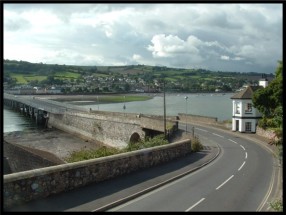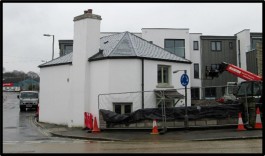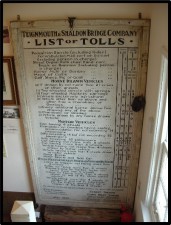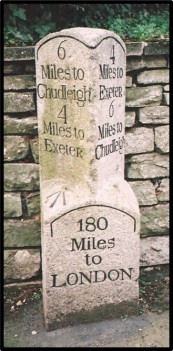
The Toll Houses of Devon
Talk by Tim Jenkinson on Thursday, 11 September 2025
at 7pm at Leonardo Hotel Exeter [Jurys Inn Exeter Hotel]
The text for the introduction provided by Tim Jenkinson revealed that our speaker was born in Staffordshire and moved to Devon in 1988, working as a Lecturer in Adult Nursing at Plymouth University until 2014. He has always been interested in local history since coming to Devon, and started to write articles about Dartmoor and its tors for Dartmoor Magazine in 1996, right up until the present day. In 2003, he became the County Representative for the Milestone Society in Devon and began exploring the vast network of roads in the county with other members, in order to locate existing milestones and tollhouses from the Turnpike era of road management in the 18th and 19th centuries. The various finds have been documented with both the Society and Devon County Council to inform their Historic Environment Record. Since 2009, he has co-authored three books with Patrick Taylor on the subject of Toll-houses in South Devon and North Devon and Staffordshire and continues to contribute to the Milestone Society’s journals and newsletters. Since 2013, together with his wife Ann, they have also surveyed roads in Jersey, Guernsey and Malta, taking photographs and location details of surviving mile markers and boundary stones.
Tim said that many items still survive at the roadside and spoke about the stone at Chudleigh that went missing in 2007 and reappeared last year. Several have been stolen, and some have been found in antique shops or in gardens. Others have been reclaimed, renovated and replaced at their original locations.
Devon has around 8000 miles of road, but only 1/5th of this distance was managed by Turnpike Trusts. Exeter was the first and largest Turnpike Trust in Devon, set up in 1753 with a remit of around 150 miles.
In their book, “The Toll-houses of South Devon”, published in 2009, Tim and Patrick give the following description of the design of toll-houses: “To facilitate the twenty-four-hour presence of their collectors, the turnpike trusts usually built small associated dwellings at their gates: the toll-houses. These generally comprised very minimal accommodation of two rooms with a scullery and privy attached, although larger types did become more common in later years. These toll-houses were either one or two storeyed and came in many shapes and sizes, some trusts adopting a standard design whilst others seem to have tried many variations, occasionally even an existing building if suitably sited, being pressed into service. If built to a normal rectangular plan, they would often have gable windows very close to the front corner of the building or a bay window on the main room to provide the collector with a view up and down the road.”
It was somewhat surprising to learn that so many of the buildings still exist, and Tim’s talk featured a wealth of photographs. Images were of Tavistock (c.1782), Okehampton (c.1830), Tavistock (c.1817), Chillaton (c.1822), Bovey Tracey (c.1826), Yealmbridge (c.1800), Stokenham (c.1856), Kingswear (c.1800), Brixham (c.1790), Shaldon Bridge (c.1827), Sidmouth Bridge (c.1827), Salcombe Regis (early 19th century), Newton Poppleford (c.1758), Honiton Copper Castle (c.1826), Bampton Town Centre (c.1819), Bampton Duvale Gate (c.1844), Tiverton North Devon, Morebath, South Molton (c.1800), Barnstaple (c.1843), Bideford (c.1828), Rothern Bridge (c.1830), Great Torrington Town Bridge (c.1830).
Those existing around Exeter include Exwick (c.1852), Cowley Bridge (c.1820), Haldon Hill (c.1842), Topsham Road (Loggerheads/Newport Lodge c.1841), Cheriton Bishop on old A30 (c.1838). Lost toll-houses include Alphington Road (demolished 1910, image provided by Dick Passmore), Countess Wear (demolished c.1973, image provided by S.A. Chandler), and Heavitree Bridge, (demolished c.1940s(?), image courtesy of Devon Record Office).
George Townsend’s paintings of 1884 were shown of toll-houses at Dunsford Gate (corner of Buddle Lane), Mary Pole Head (Rosebarn Lane), Mount Radford Gate (Topsham Road), Elmfield (New North Road), Stoke Hill (foot of Rose Barn Lane), Red Cow (Red Cow Village at bottom of St David’s Hill), Withybridge (Black Boy Road), Okehampton Road (opposite the old Workhouse), Livery Dole (at corner of Magdalen Road/Barrack Road).
Private toll-houses that are still in existence are at Braunton Marsh, Petrockstowe, Lee Abbey at Lynton, and another at Petrockstowe under the ownership of Lord Clinton.
Toll huts are still used to charge visitors at Braunton Marshes and Hartland Point in North Devon. There are also surviving toll huts from the turnpike era at Yealmbridge and Little Haldon. At Headway Cross above Bishopsteignton, where another hut once stood, there is a ring rock used to tether the toll keeper’s horse.
Lost and demolished toll-houses are Alma Rock Plymouth (c.1924), East Budleigh (c.1977), Coryton (c.1940), Kingsbridge (c.1933), Penn Inn Newton Abbot (c.1968), True Street Berry Pomeroy (c.1972), Halberton Tiverton, Millbridge Plymouth.
Demolished since 2009 are Holyshute Cottage Honiton (2012) and Forches Cross Newton Abbot (2009). A photo of Langford Bridge taken in March 2013, along with the house, and a photo taken in November 2014 showed when it was demolished.
Some toll-houses have been saved from demolition and Tim showed as an example West Bridge Tavistock Toll-house with images from August 2013, October 2014 and February 2016.
Tim showed images of toll-houses taken by G.W. Copeland 70 years ago, and then images of how the toll-houses now appear in 2025: Monksbridge Brixham, Colleton Mills, Bovey Tracey, and Shaldon Bridge.
Some toll-houses have suffered damage: Avonwick South Hams now Grade II listed; Exebridge Morebath was damaged by a vehicle, and Gunnislake was damaged by a lorry in 2010. Tim showed a delightful photo of Exwick toll-house with the toll keeper’s family lined up outside c.1901.
Life as a tollgate keeper could be hazardous as people were apt to cause damage if they resented paying the toll, but some have been found to occupy the same premises for a long time, one as much as fifty years. Male keepers often combined the job with an extra occupation to earn more money, and quite often women would take the tolls or be the appointed toll-keeper. There would be a toll board affixed to a wall showing the various prices depending on whether the travellers were on foot, on horse, or in a wheeled carriage or vehicle. The North Devon Journal of 1838 featured articles about evasion of tolls [much as fare dodgers on current-day trains!].
Tim then turned his attention to Milestones and Mileplates and showed images of Crockernwell milestone on the old A30 Exeter and Okehampton Turnpikes, along with other West Devon Milestones such as Chichacott Bridge, Weir Bridge, Folly Gate, Lower Langford, Friars Hele Cross, Near Firestone Cross.
Milestones Grade II listed in September 2017 can be found at Alphington, Kenn, Harcombe and Chudleigh.
Cast Iron Mile Plates can be found at Higher Brixham, Brixham, Babbacombe, Cruwys Morchard (which had been stolen and subsequently put back), Clappery Mill, and St Marychurch.
Cast Iron Mileposts can be found at Chillaton, Ivybridge and Derriford.
Tim spoke about the Milestone Society which is a registered charity founded in 2001 and has an established network of county representatives, a national committee and a national database. Work is done by volunteers to renovate mileposts. Tim showed photos depicting the original state of some milestones and the work done to restore them. Another series of photos showed a milestone being put back in position at Ashcombe Cross on the A380 in March 2006. A vehicle had knocked it out, and fortunately car insurance had paid the costs of putting it back. In Petrockstowe, Ann Tompkins has worked tirelessly to discover milestones hidden in hedges and has cleared vegetation to make them visible again.
Tim ended his talk by relaying a story about the Hertfordshire Scouts attending a camp in Devon and taking away a milestone. In October 2020, it was returned to County Hall after 63 years away. It was then taken back to the Museum of Dartmoor Life awaiting replacement in its original position. Tim showed a South Zeal Mineral Rights boundary stone dating to 1884 plus an Information Board.
This was an extremely interesting and informative talk with countless images of toll-houses and milestones, followed by questions. Tim had copies of his two books, along with postcards of milestones, for sale. Having purchased them myself many years ago at another talk, I can thoroughly recommend them for the wealth of images and history of turnpike trusts that they contain.
Sue Jackson
(All images supplied by Tim Jenkinson)





